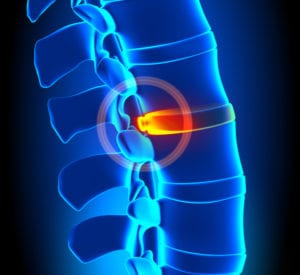 If you have recurring back pain or sciatic nerve pain, you may have a bulging disc. Sometimes referred to as a slipped disc, a bulging disc can cause unbearable pain in the lower or upper back, shoulders, neck, and arms, as well as pain in the legs, thighs and feet. Unlike a herniated disc, a bulging disc may come on slowly, or may be triggered by a sudden event or injury.
If you have recurring back pain or sciatic nerve pain, you may have a bulging disc. Sometimes referred to as a slipped disc, a bulging disc can cause unbearable pain in the lower or upper back, shoulders, neck, and arms, as well as pain in the legs, thighs and feet. Unlike a herniated disc, a bulging disc may come on slowly, or may be triggered by a sudden event or injury.
Symptoms of a Bulging Disc
A bulging disc may occur in any section of the spine, though it most frequently happens in the lumbar (lower) region of the back.
The most common symptoms of a bulging disc include:
- Pain or tingling in the neck, shoulders, arms hands or fingers
- Upper back pain that radiates into the chest or abdomen
- Pain in the buttocks, thighs or feet
- Sciatic pain in one leg, when the disc compresses the sciatic nerve
What Causes a Bulging Disc?
The spine is composed of a number of bones (vertebrae) that are separated by discs of cushioning layers of collagen. These discs absorb shock and allow for flexible movement of the spine. When the shape of the disc protrudes outside the circumference of the vertebrae, it can put pressure on the nerves in your back, and lead to painful symptoms.
A bulging disc may develop slowly over a period of years, yet not cause any noticeable symptoms until it protrudes enough compress a nerve root or the spinal cord itself. A family history of disc problems may make you may be more likely to develop a bulging disc.
It may also develop as a result of:
- Disc degeneration that comes with aging
- Sedentary lifestyle
- Injury or overstretching the spine
- Bad posture or poor orthopedic support
- Lifting with the back, rather than the legs
Without treatment, a bulging disc can develop into a herniated disc, which may
How is a Bulging Disc Diagnosed and Treated?
If you have back pain, your doctor will use imaging tools such as x-ray, CT scans and MRIs to locate the affected disc. With a positive diagnosis, your doctor may recommend surgery or non-surgical treatments, depending of the severity of the bulge and your symptoms.
Non-Surgical Treatment with Dr. Doyle
Whether you have already received a positive diagnosis of a bulging disc or not, Dr. Cody Doyle can help!
During your consultation, Dr. Doyle will perform a detailed physical examination and diagnostic scans, listen to your symptoms, and create a customized plan for alternative treatments to address your unique needs.
Dr. Doyle may use a combination of treatments to treat a bulging disc, including chiropractic care and acupuncture. Adjustments to the spine can relieve the pressure on the disc and reduce the nerve irritability that causes pain, muscle spasms and inflammation in the back and legs. While acupuncture cannot correct the bulging of the disc tissue, it can relieve the swelling and pain that results. If your bulging disc is not severe enough to warrant surgery, acupuncture may help keep painful symptoms at bay.
Physical therapy and lifestyle modifications may also be used to help alleviate your symptoms and promote proper alignment of the spine and discs.
Why Choose Nonsurgical Treatment?
More and more people are turning to complementary therapies to avoid surgery these days. There are a lot of good reasons to do this. Surgery requires hospitalization and strong pain medications, and can cost an arm and a leg, even with good insurance!
In the past 20 years, Dr. Doyle has successfully treated more than 100,000 patients with a broad range of health concerns, including spinal conditions. He has experience treating bulging discs and can offer you a personalized approach to managing your pain.
Call us today for Roanoke bulging disc treatment! To reach our Roanoke, TX office, contact us online or call (817) 767-5430. For La Grange, TX patients, contact us online or by calling (979) 968-6400.
Roanoke Bulging Disc Treatment – Doyle Chiropractic and Acupuncture